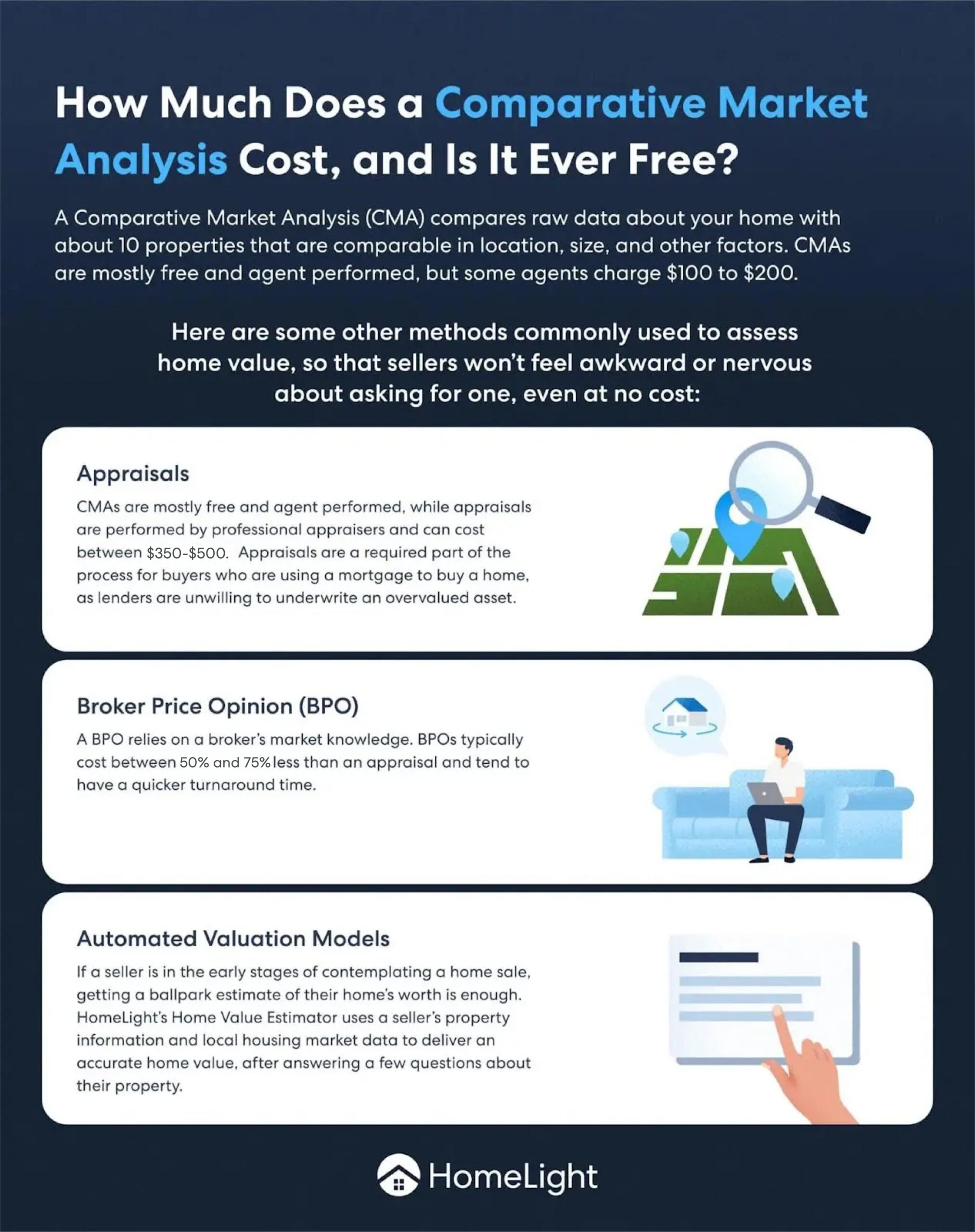How Much Does a Comparative Market Analysis Cost, and Is It Ever Free?
- Published on
- 7 min read
-
 Ashlyn Needham, Contributing AuthorClose
Ashlyn Needham, Contributing AuthorClose Ashlyn Needham Contributing Author
Ashlyn Needham Contributing AuthorAshlyn Needham is a freelance writer with years of experience covering real estate and home improvement topics. Her favorite pastime is tackling home improvement projects, reading, and writing real estate, food, and lifestyle blogs.
-
 Taryn Tacher, Senior EditorClose
Taryn Tacher, Senior EditorClose Taryn Tacher Senior Editor
Taryn Tacher Senior EditorTaryn Tacher is the senior editorial operations manager and senior editor for HomeLight's Resource Centers. With eight years of editorial and operations experience, she previously managed editorial operations at Contently and content partnerships at Conde Nast. Taryn holds a bachelor's from the University of Florida College of Journalism, and she's written for GQ, Teen Vogue, Glamour, Allure, and Variety.
Looking to list your home? Before you publish your listing, you might be wondering how much value your home has acquired since you bought it. Whether you’ve lived in your home for a while or totally spruced up the place, a comparative market analysis (CMA) can determine your home’s value with a high degree of accuracy. But how much does a comparative market analysis cost?
A CMA is typically performed by a licensed real estate agent, and having one written up for your house can vary in price. While most agents will perform a CMA for free, some may charge a small fee. If you’re listing your home with an agent, a CMA will almost always be included in the services they provide.
Let’s look closer at CMAs and some other methods commonly used to assess home value so that you won’t feel awkward or nervous about asking for one, even at no cost.
How much does a comparative market analysis cost?
Some agents charge from $100 to $200 for a CMA, says George Herring, a top real estate agent and single-family homes expert serving the McKinney, Texas, area. But Herring doesn’t charge anything. In fact, many agents advertise free CMAs as part of their marketing. Some agents will even include CMAs when they mail out fliers to certain subdivisions on a regular basis to drum up business.
“I do free CMAs for people all the time,” says Herring.
The idea is to try to find a similar product in upgrades, age, and square footage. You want to only go 500 square feet above and below the subject property, and then if you have enough examples, you squeeze that in even further.
 George Herring Real Estate AgentClose
George Herring Real Estate AgentClose George Herring Real Estate Agent at Re/max DFW Associates Currently accepting new clients
George Herring Real Estate Agent at Re/max DFW Associates Currently accepting new clients
- Years of Experience 28
- Transactions 442
- Average Price Point $350k
- Single Family Homes 432
Factors that go into a CMA
A CMA compares raw data about your home with about 10 properties that are comparable in location, size, and other factors. These properties are known as “comps.” Your real estate agent searches the Multiple Listing Service (MLS) for current and previous listings over the past three to six months, depending on market conditions. They’re looking for how long homes like yours took to sell and the difference between their list prices and their sale prices.
“The idea is to try to find a similar product in upgrades, age, and square footage,” says Herring. “You want to only go 500 square feet above and below the subject property, and then if you have enough examples, you squeeze that in even further.” Even better, according to Herring, is keeping comps within the same subdivision, which helps ensure that homes have a similar age and similar finishes.
In addition to square footage and the number of bedrooms and baths, a CMA will include any amenities or features the comparable properties have, such as a swimming pool, as well as any less tangible factors, such as whether a home is close to noisy streets.
A CMA report contains the following elements:
- The MLS number
- Address
- Number of bedrooms and bathrooms
- Square footage
- Amenities such as a pool
- Price per square foot
- Sold date
- Sale price as a percentage of list price
- Number of days on the market
Your CMA is a valuable document in helping you establish an appropriate listing price after seeing how much value your home has built over the years. Without a solid eye for detail or knowledge of how to best assess your property and its features and history, you could accidentally sell yourself short. That’s why it’s best to have an experienced agent perform the job for you.
Using a CMA to prepare for your sale
A CMA is how an agent arrives at a suggested listing price, but it’s also so much more. Even if you’re not ready to sell, getting a CMA report done early can help prepare you for the home-selling process.
Home renovations play a key part in increasing your home’s value and listing price, but you have to be strategic in what you choose to renovate. Some home renovations may have a low ROI, so the money you invest for a remodel does not come back when you sell.
“You really have to have [the CMA] in order to make an educated decision as far as whether you want to sell your house in its current condition, or does it make sense for you to spend $30,000 to renovate your kitchen and your master bath? And hopefully, you could get $55,000 back,” Herring says. “Last thing you want to do is spend a bunch of money and not have it do any good for the home.”
So, seeing a CMA report early can help you make better decisions about your home’s future. Depending on the remodeling project that you would like to complete, it could take a few days or up to one year for the project to be finished.
Renovations of any kind need to be planned ahead of time before you sell. A CMA report can help you prioritize your future decisions and highlight what options are best to take before you put your home on the market.
Without setting the pricing of your home fairly and accurately, you could be in for a slight disappointment. Homes that are too overpriced for their local market tend to just sit until price adjustments are made. Starting with a home value estimator and then looking at a CMA can help you and your real estate agent judge what the fair price for your home is to get it sold quickly.

Online value estimators and other appraisal methods
Every homeowner is curious as to how much value their home has, and one popular method homeowners choose to take is through an appraisal. While an appraisal and a CMA are similar, they differ in important ways.
Appraisals
CMAs are mostly free and performed by agents, while appraisals are performed by professional appraisers and can cost between $350-$500. Appraisals are a required part of the process for buyers who are using a mortgage to buy a home, as lenders are unwilling to underwrite an overvalued asset.
Broker price opinion
Another valuation method some homeowners choose is a broker price opinion (BPO). A BPO relies on a broker’s market knowledge. BPOs typically cost between 50%-75% less than an appraisal and tend to have a quicker turnaround time.
Automated valuation models
Sometimes, it’s enough just to have a more ballpark estimate of your home’s worth, particularly if you’re in the early stages of contemplating a home sale. HomeLight’s Home Value Estimator uses your property information and local housing market data to deliver an accurate home value, after you answer a few questions about your property.
An online estimate is great at giving you a general idea of your home’s current value. To get a true value, you should partner with a top agent to help determine pricing strategy when the time comes to sell your home.
Header Image Source: (Luke Southern / Unsplash)




